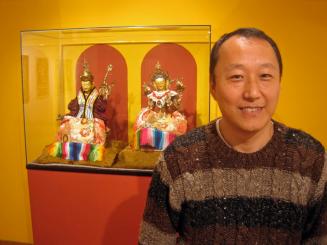Jampa Tsondue at Exhibition Talk for CCHAP 25th Anniversary Exhibit
SubjectPortrait of
Jampa Tsondue
(Tibetan, born 1959)
Date2016 November 3
Mediumborn digital video
DimensionsDuration: 1 Minutes, 58 Seconds
ClassificationsGraphics
Credit LineConnecticut Cultural Heritage Arts Program collections
CopyrightIn Copyright
Object number2015.196.283.4
DescriptionVideo of an Artists Talk at the Connecticut Office of the Arts Gallery held in conjunction with the exhibition, "Connecticut Traditional Artists and Their Communities: An Exhibit Celebrating 25 Years of CCHAP."
Video of Jampa Tsondue describing the Tibetan butter sculpture he made.
NotesSubject Note: In 2016, the Connecticut Cultural Heritage Arts Program (CCHAP) at the Connecticut Historical Society (CHS) marked 25 years of documenting the state’s diverse cultural traditions and sharing the artistic creations and community cultural practices of folk artists living here. To celebrate this achievement and honor their longtime partnership, the Connecticut Office of the Arts (COA) hosted a new exhibit curated by CCHAP. "Connecticut Traditional Artists and Their Communities" displayed a variety of ethnic, occupational, and native arts that are thriving throughout the state.Video of Jampa Tsondue describing the Tibetan butter sculpture he made.
"Connecticut Traditional Artists and Their Communities: An Exhibit Celebrating 25 Years of the Connecticut Cultural Heritage Arts Program" highlights the work of Connecticut folk artists whose creativity expresses the history, cultures, values, and beliefs essential to their heritage. Their skills have been learned from family and community members over years of observation, practice, and artistic participation. Artists included Peruvian woodcarver and furniture restoration expert Romulo Chanduvi, Polish iconographer and community folklorist Marek Czarnecki, Ukrainian pysanky (decorated eggs) master Paul Luniw, and Q Delpeche, creator of brilliant Trinidad-style Carnival costumes. Several skilled textile artists from newcomer groups including Bosnian, Burmese Karen, and Assyrian displayed their weavings, embroideries, and lace. The Finnish community from eastern Connecticut showed woodcarvings, weavings, and sauna decorations, and the Tibetan community displayed thangka paintings, woven rugs, and a sand mandala. Connecticut-based Native American artists displayed flutes, pottery, and finger weaving. Occupational artists from maritime, ironwork, decoy carving, and shoe-making traditions illustrated the crafts of working communities. Additional artists included Lithuanian artists Aldona Saimininkas and Asta Nenortas, Cambodian costume designers Sotha Keth and Sophanna Keth Yos, Ukrainian embroiderer Zirka Rudyk, Laotian community artists Khoutavong and Manola Sidara, Ugandan musical instruments made by Gideon Ampeire, and National Heritage Fellowship awardee Eldrid Arntzen.
Artists described their work at a public exhibition talk held on November 3, 2016.
The exhibition ran from August 11 - November 4, 2016, at the Gallery at Constitution Plaza, Hartford. The exhibition was supported by the National Endowment for the Arts, the Connecticut Office of the Arts, and the Connecticut Historical Society.
Biographical Note: Jampa Tsondue was born in 1959 just after his parents arrived in India, having left their farmland in Shigatse near Lhasa. Settling in Darjeeling, the family was visited by a monk-painter who noticed Jampa's talent. After school each day from the age of thirteen Jampa took art lessons from this teacher, Ngawang Norbu. Later Jampa moved south to Mysore to become an apprentice to this famous painter at the Gyudmed Tantric University, studying techniques of thangka painting for five years. The bond between master teacher and student can become very strong, almost familial. Jampa worked with his teacher, who also lived with the family, for the next fifteen years. Together they accepted commissions for thangka paintings, murals, and restoration of old art works. Their most important project took four painters nearly four years to complete - recreating forty-one thangkas in the Dalai Lama's collection, each 4 feet by 3 feet, depicting the past lives of the Buddha. Hung in Buddhist monasteries and family shrines, thangkas usually depict spiritual beings. By viewing and meditating deeply upon a thangka, one's own character can become imbued with the qualities of the figure represented, as a way to transform the self. The process of creating a thangka can be a devotional act for the artist.
In 1992 Jampa was chosen by lottery to come to America with 1000 Tibetans, and he settled in Old Saybrook where he still lives. Although working and raising three children, Jampa has completed several thangkas in America although each requires a long process; he does not make them for sale. Every Tibetan has a home altar, and Jampa has created an altar in his house where his thangkas are used by his family for meditation. He has been very active in the Tibetan Association of Connecticut, a social organization that serves the nearly 500 Tibetans that have settled in Connecticut (growing from the 21 who came in 1992). Jampa participates in community gatherings to celebrate Losar, New Year, and the Dalai Lama’s birthday. In February 2007 Jampa’s paintings and drawings were on display at Wesleyan University, at the Mansfield Freeman Center for East Asian Studies, organized by Patrick Dowdey, curator and professor at the Freeman Center. Jampa also did a demonstration of thangka painting there. This was his first exhibition in many years, and his first solo exhibit. Exhibitions and demonstrations featuring Jampa’s work have taken place at Trinity College, Hartford, the Ambassadors of Folk: Connecticut Master Traditional Artists exhibit at the Institute for Community Research in Hartford, the Auspicious Signs: Tibetan Arts in New England exhibition also at ICR, and an exhibit at the Connecticut Office of the Arts Gallery that celebrated 25 years of the Connecticut Cultural Heritage Arts Program. Jampa has taught his daughter Yangzom to create thangkas. In 2015 Jampa received a Folk Arts Fellowship from the CT Office of the Arts.
Additional materials exist in the CCHAP archive for these artists and this event.
Cataloging Note: This project was made possible in part by the Institute of Museum and Library Services MA-245929-OMS-20.
Status
Not on viewJampa Tsondue
2018 March 10




